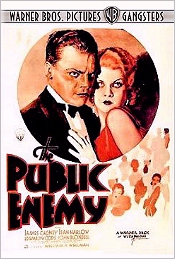 |
The Public EnemyWarner Brothers |
|---|
 |
The Public EnemyWarner Brothers |
|---|
|
James Cagney - Tom Powers Jean Harlow - Gwen Allen Edward Woods - Matt Doyle Mae Clarke - Kitty Joan Blondell - Mamie |
William A. Wellman - Director Darryl F. Zanuck - Producer Harvey F. Thew - Screenwriter Dev Jennings - Cinematographer David Mendoza - Film Score |
Like Rico Bandello in Little Caesar (1930), James Cagney's Tom Powers is a Catholic (Irish, not Italian) who suffers from sexual inadequacy. The grapefruit he smashes in Mae Clarke's face suggests misogyny, while Jean Harlow's consoling cradling arms hint at a mother complex.
The difference between the two films, aside from William Wellman's clear superiority to Mervyn LeRoy as a director, is that The Public Enemy attempts to answer the charges of irresponsibility laid against the gangster movie by providing some sort of sociological context. Hence the series of vignettes with which the film opens, moving on from images evocative of a poor immigrant neighborhood. The city in the thirties gangster story is not quite the same city that appears in film noir. With its documentary shots of city streets, and its sense of the pulse and flow of city life, the prologue to The Public Enemy is unusual, for most gangster films are confined to interiors--studio sets designed to imitate reality.
As children, Tom Powers and his buddy Matt (Edward Woods) graduate from innocent mischief to theft and the accidental first use of a firearm. Cagney, as he grows up and with the coming of Prohibition, becomes a full-fledged gangster, now given to unpredictable bouts of violence and even viciousness (when he pauses, allowing a stool-pidgeon a cruel moment of hope before he is killed), but still anarchically and unmistakably his own man.
However, Cagney's Powers is not victim of social conditioning, sandwiched between an inflexibly righteous policeman father and a fondly indulgent mother. Rather, he is a free-booting spirit exulting in the freedom of action as a gangster which enables him to beat the Depression (and to win audience approval for smacking the clinging Clarke with a grapefruit as she tries to inhibit his enterprise).
Where Edward G. Robinson's Rico Randello was represented as an unmitigated rat, in other words, Tom Powers is a hero in night disguise. Not white-washed by any means, but sufficiently sympathetic for his last, enigmatically muttered words--"I ain't so tough"--to redouble the shock of his retribution when he is dumped, a bullet-ridden corpse trussed up like a turkey, on his mother's doorstep while a scratchy gramophone record plays "I'm Forever Blowing Bubbles."
As a backlash to this characterization, all the scenes involving Tom's good brother (Donald Cook), and pressing the crime-does-not-pay image, seem not only embarrassingly inadequate but positively anti-message. But, given the episodic structure of the script and the narrative drive of Wellman's direction (with marvellous setpieces like the fur store robbery and the machine-gunning of Woods), The Public Enemy barely acknowledges these lapses as it races exhilaratingly on.
--PHIL HARDY, from The Gangster
Film Encyclopedia, 2001.
A selection of Public Enemy related films.
|
Find Public Enemy on eBay.com
A selection of Public Enemy related books.
|
|
home: The Film Noir 'net |
back to: ALMOST NOIR |
|
Any comments, additions or suggestions
should be addressed to: The Film Noir 'net / Eric B. Olsen / ericbolsen@juno.com |
Other Web Sites:
History of Horror Hard Bop Homepage The War Film Web Author Eric B. Olsen |